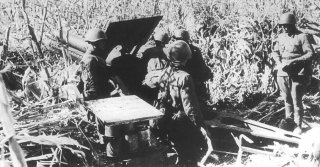Soviet Soldiers Strangely Lacked Seemingly Essential Socks
Footwraps, or Portyanki, have been used for centuries.
Here's What You Need to Know:Soviet soldiers stuffed their feet into long, laceless leather boots. But not with socks. Instead, they used scraps of stinky rags.
Near the end of World War II, American service members encountered something that was rather difficult for them to understand. While American troops, and virtually all troops for that matter, used boots that laced up with long socks underneath, their Soviet allies wore something a bit different. Soviet soldiers stuffed their feet into long, laceless leather boots. But not with socks. Instead, they used scraps of stinky rags.
Though we take them for granted, socks were considered a luxury item reserved for the rich. This was especially true prior to the industrial revolution because, at the time, socks were more time-intensive to manufacture. Rather than diverting resources to and manpower to socks, troops were issued simple cloth scraps. The logic of foot wrappings over socks is simple: if a lowly scrap of cloth worked in the past—not only sufficed but contributed winning wars—then why change?
Footwraps, or Portyanki as they are known in Russian, were essentially large rectangular pieces of cloth that were carefully wrapped around each foot. The wrappings served in much the same role as socks, to wick moisture away from the foot, prevent blistering and chafing, and to keep dirt and rocks out of the boot.
Still, they were not as simple as pulling a sock over a foot. They had to be carefully and tightly bound around the foot and the ankle, similarly to how a bandage or ankle brace would be wrapped around an injury. Perfecting the technique required practice. If you didn’t get it down pat, then you’d not only be punished for being slow, you’d pay in the form of blisters and intense discomfort.
Portyanki have been used for centuries. Every Russian army since the days of Peter the Great marched into battle on rags rather than knits. There were even summer and winter issues—cotton for warm times, flannel for when it was cold. Sometimes haltingly, Russian military modernization nonetheless progressed—and probably about time too.
Moving into Modernity, One Step at a Time
In 2013, the Russian defense minister Sergei Shoigu finalized the switchover from Portyanki to socks during a television briefing, ending the old-fashioned practice once and for all. He was quoted as saying the Russian military should have “forgotten” the word Portyanki and long since moved toward more modern foot textiles.
“In 2013, or at least by the end of this year, we will forget foot bindings,” he instructed. “I’m asking you, please, if there is need we will provide additional funds. But we need to finally, fully reject this concept in our armed forces.” Better late than never.
Caleb Larson is a multimedia journalist and Defense Writer with The National Interest. He lives in Berlin and covers the intersection of conflict, security, and technology, focusing on American foreign policy, European security, and German society.
This article first appeared in June 2020.
Image: Wikimedia Commons

